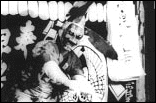|
|
 |
Producer: Kudo Mitsuru Director, Scriptwriter: Haneda Sumiko Photography: Nishio Kiyoshi, Segawa Jun'ichi, Wakabayashi Hiromitsu, Nishiyama Haruo, Tashiro Keishi, Naito Masayuki, Shimodaira Motomi, Chiba Hiroshi Lighting: Fujiki Yoshikado, Soda Takehisa, Watanabe Katsutoshi Sound: Kubota Yukio Music Director: Akiyama Kuniharu Narrator: Okata Hisako. 1982 / Color / 16mm / 186 min / English subtitles |
| Iwate Prefecture, Ohasamacho. In the foothills of Mt. Hayachine, the kagura (devotional dance) offered to the mountain goddess by the mountain priests is still performed today nearly unchanged from mediaeval times. This dance, which has been handed down along several lines of succession in the villages of Take and Otsugunai, has its origins in prayer. Take's kagura and Otsugunai's kagura are said to be closely related. The film shows the people who lovingly continue to perform these two types of dance and the transition from ancient tradition to modern life. Even from the first moment that director Haneda was charmed by Hayachine's kagura, the mountain villages that were home to the gods had already begun to disappear. However, Haneda matches changes in the film's style to changes which took place over the years and months before she began filming. From images of a traditional style house being torn down in one spring to the next year's thaw, she paints a portrait not of an as yet undiscovered pocket of tradition, but of the people who coexist with the traditional and the modern. |